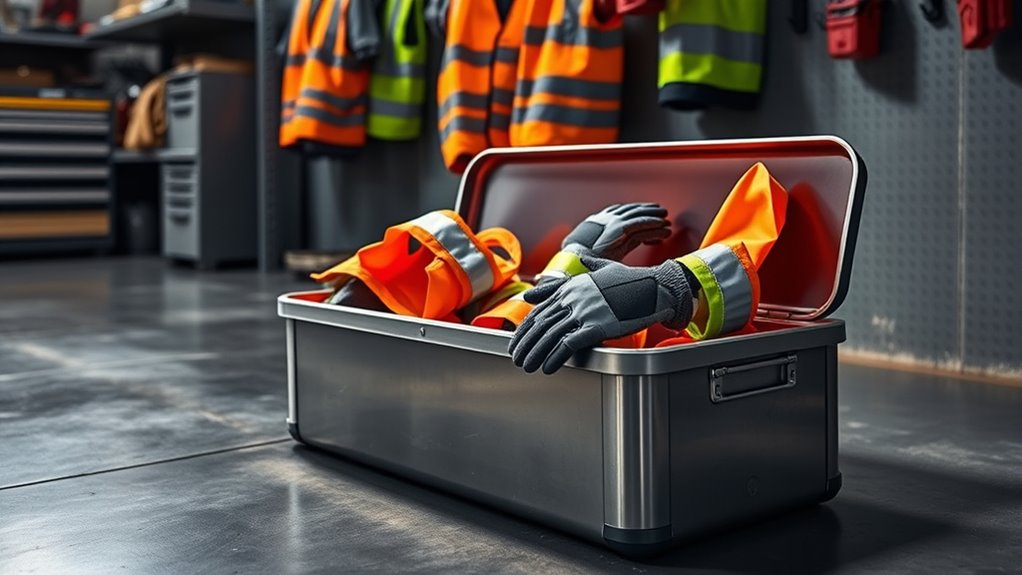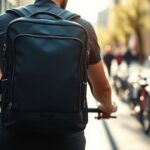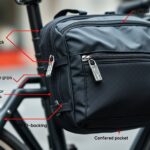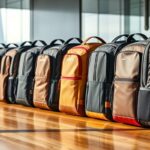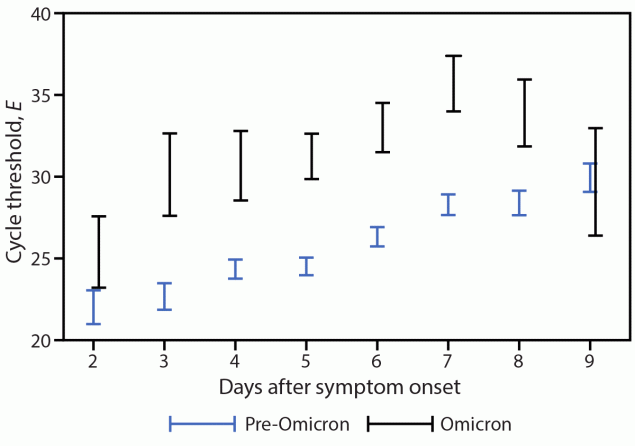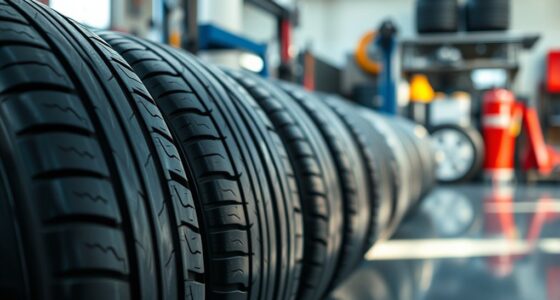To maximize safety and utility in reflective gear storage, focus on using high-visibility materials like Scotchlite™ and fluorescent fabrics for 360° visibility. Choose gear with practical compartments such as radio pockets, pencil sleeves, and easy-access zippers. Opt for durable, weather-resistant fabrics with reinforced stitching. Designing with comfort in mind, add multiple quick-access pockets and secure straps. Staying organized and ensuring your gear is easily accessible helps keep you safe, especially in low-light conditions—exploring these tips will help you optimize your safety setup.
Key Takeaways
- Incorporate dedicated compartments like radio pockets and pencil sleeves for organized, quick access to safety equipment.
- Use durable, weather-resistant materials with reinforced zippers to protect gear from harsh conditions.
- Position reflective strips on multiple angles and attach to gear for 360° visibility in low-light environments.
- Utilize high-visibility colors and reflective materials to enhance daytime and nighttime conspicuity.
- Design storage solutions with easy-to-access pockets and clip points to improve safety and operational efficiency.
Maximizing Visibility With Reflective Materials
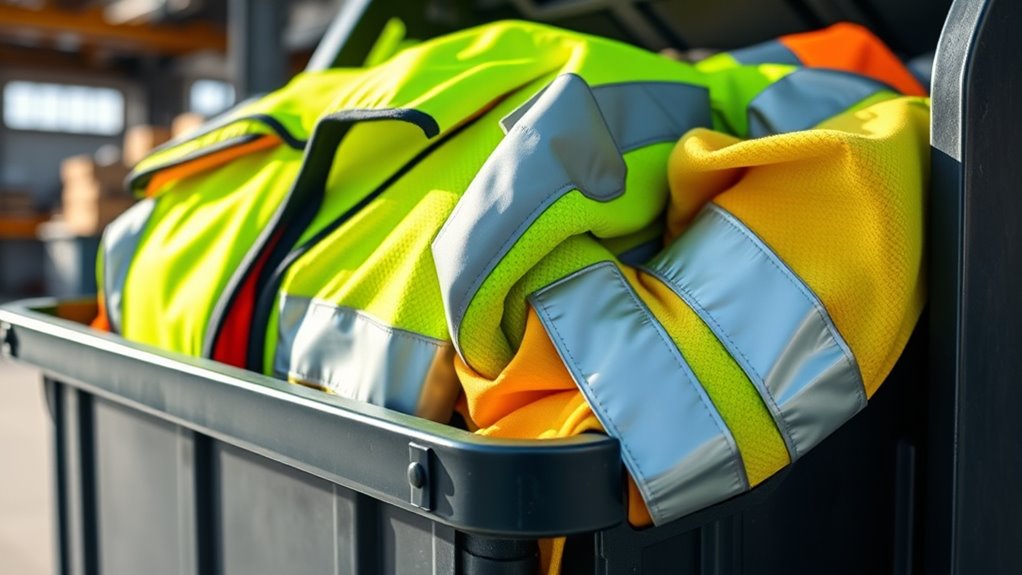
To maximize visibility with reflective materials, it is vital to strategically place reflective strips and panels on your gear. Reflective materials like Scotchlite™ and Brilliant Plus Reflective™ reflect light directly back to its source, making you easily seen in low-light conditions. Use high-visibility safety vests with fluorescent colors like lime yellow, which boost daytime conspicuity, while reflective elements enhance nighttime safety. Position reflective strips, such as 1-inch high-performance tape or 4.5-inch contrasting panels, on multiple angles to guarantee visibility from all directions. Incorporate reflective edging and trim, like Brilliant Trim Reflective, to outline your shape and movement, increasing safety in any lighting. Proper placement and quality of reflective materials can make you visible from over 1,000 feet away, considerably reducing risks. Additionally, selecting reflective materials with durability and weather resistance ensures long-lasting effectiveness in outdoor environments. Choosing materials with weather resistance is especially important to maintain safety during rain or snow conditions, as exposure can degrade less durable options. Moreover, opting for reflective gear with UV protection can help prevent material deterioration over time due to sun exposure, maintaining their effectiveness.
Practical Storage Solutions for Safety Gear
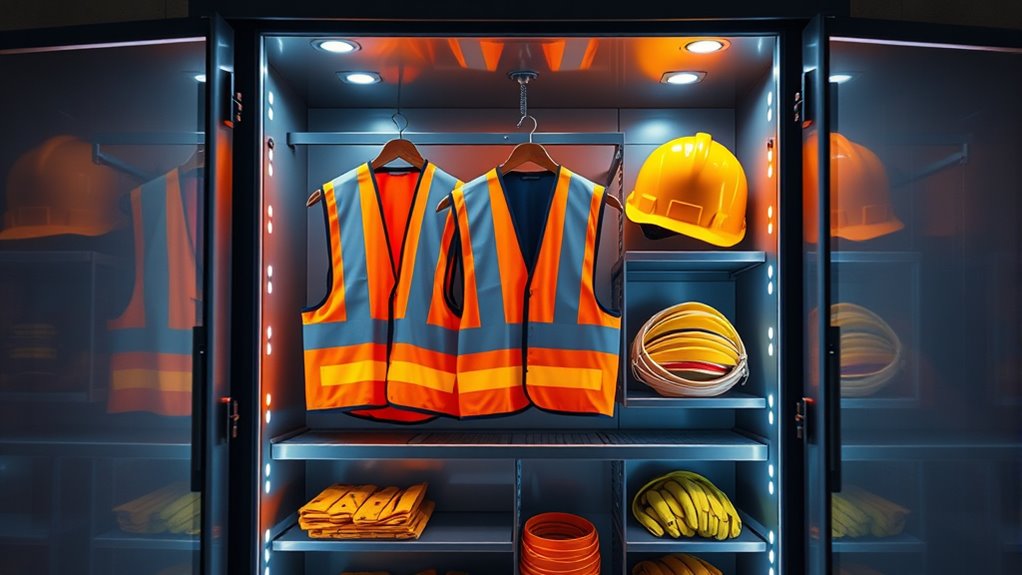
Effective safety gear storage solutions help you stay organized and prepared in demanding work environments. To maximize safety and utility, focus on features like pockets, gear loops, and clip points that keep tools accessible. A well-designed storage system can also maximize space and organization, ensuring that your gear is easily reachable without cluttering your workspace. Reflective vests with specialized compartments—such as pencil sleeves, radio pockets, and load-bearing tablet pockets—boost functionality and safety. Strategically placed pockets on the front, inside, and back of your gear allow quick access, enhancing mobility during emergencies. Durable materials like heavy-duty nylon and reinforced zippers ensure your storage withstands harsh conditions. Incorporating proper storage techniques can further optimize your gear management and safety, especially considering the importance of compassion and support in high-stress environments. Additionally, understanding home security systems can inspire innovative ways to secure and organize your safety equipment effectively. Recognizing the value of essential oil properties can also be useful when selecting materials that resist odors and maintain cleanliness in your storage solutions.
Durable Fabrics and Construction for Work Environments

Choosing the right fabrics and construction methods is essential for ensuring your safety gear can withstand demanding work environments. Durable fabrics like heavy-duty nylon, polyester, and reinforced polyester mesh are key to withstanding harsh conditions and frequent use. High-quality construction features reinforced stitching, especially around stress points like pockets and zippers, to prevent tears and extend gear life. Weather-resistant fabrics, including water-resistant and windproof outer layers, protect you from diverse elements while maintaining gear integrity. Heavy-duty zippers, webbing, and reinforced seams add to the overall robustness, ensuring secure closures and durability over time. Incorporating these materials and construction techniques helps your reflective gear stay functional, reliable, and safe, no matter how tough the work environment gets. Additionally, understanding the importance of AI safety measures can aid in designing smarter, more resilient protective gear that adapts to evolving safety standards. Emphasizing Kia Tuning principles, such as using high-quality materials and precise construction, can serve as a valuable analogy for optimizing safety gear durability and performance. Paying attention to newborn safety guidelines in your gear design can further enhance user protection in demanding environments. Considering Honda Tuning concepts, like precise fabrication techniques, can also inspire improvements in gear longevity and safety features.
Designing for Comfort and Ease of Access
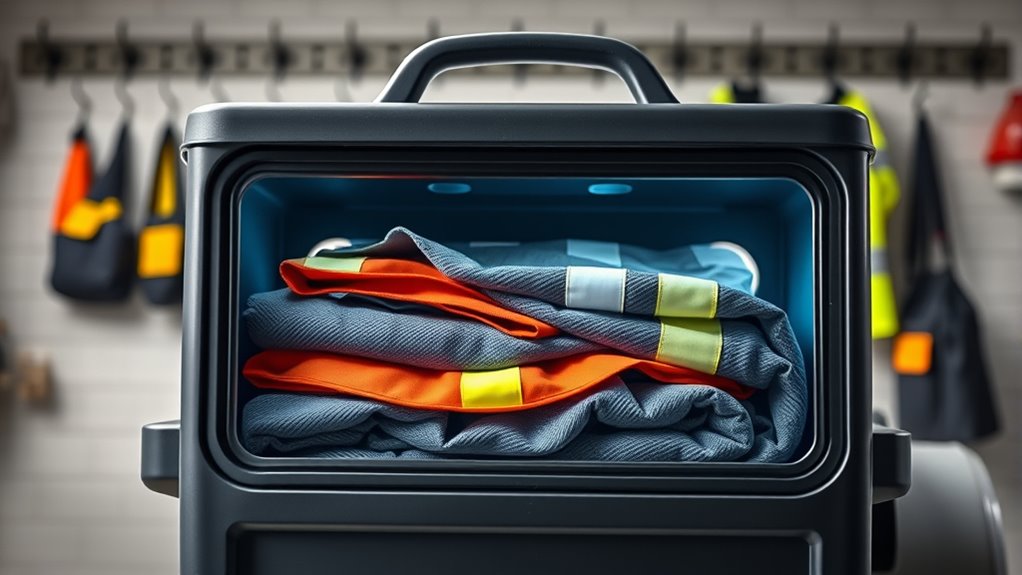
Ever wonder how your reflective gear can maximize both comfort and functionality? Designing for ease of access involves smart features that keep you comfortable and organized. Incorporate multiple chest pockets in your utility vest for quick access to essentials, with reflective tape for visibility. Use lightweight, breathable materials like mesh to reduce fatigue during long wear. Add gear loops and pencil sleeves for securing tools without bulk. Secure zippers and load-bearing straps ensure tools stay in place while allowing easy donning and removal. Selecting ergonomic designs can further improve comfort and ease of access during use. These features distribute weight evenly, decrease discomfort, and make accessing gear effortless. Additionally, considering remote hackathon principles can inspire innovative solutions for portable and adaptable gear storage options. Emphasizing best practices in safety gear ensures your reflective gear remains both safe and user-friendly. Incorporating safety standards helps ensure your reflective gear meets essential safety requirements without sacrificing comfort, making your reflective gear both safe and user-friendly. Implementing material selection strategies can further enhance durability and comfort in various conditions.
Enhancing Safety in Low-Light and Night Conditions
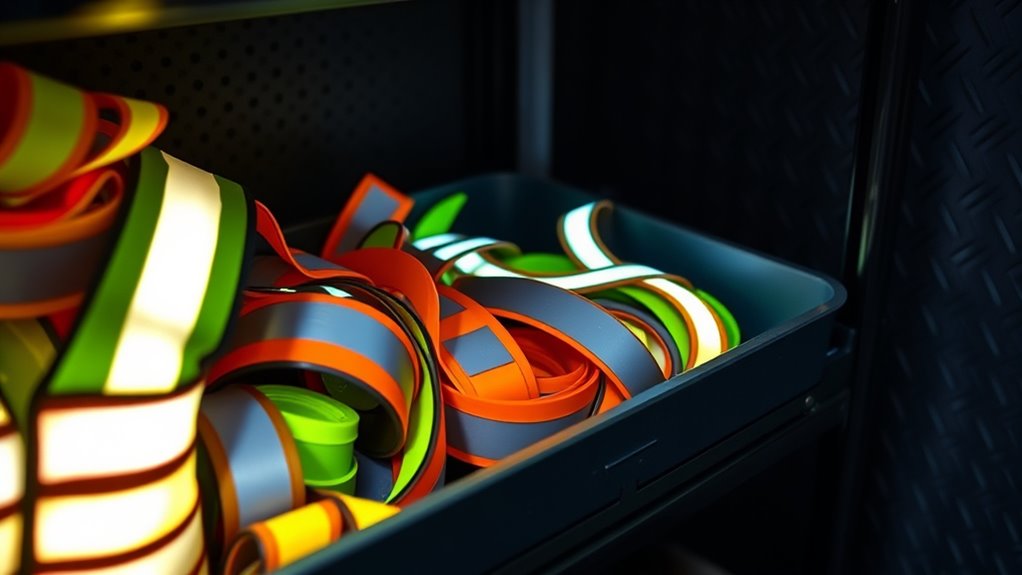
To enhance your safety during low-light and nighttime conditions, it’s essential to use reflective gear that maximizes visibility from all angles. Properly stored reflective gear with high-visibility materials like 3M™ Scotchlite™ ensures you’re seen from every direction, boosting night safety. Reflective gear with multiple pockets and clip points keeps your safety accessories organized and accessible, reducing distractions and improving situational awareness. Combining fluorescent colors with reflective strips further increases daytime visibility, helping you stay visible during dusk or dawn. Regular maintenance and correct storage prevent the deterioration of reflective materials, maintaining their effectiveness in low-light environments. Additionally, understanding industry trends and legal considerations for safe and compliant use of reflective gear can enhance your overall safety practices. By choosing and caring for your reflective gear properly, you considerably improve your safety and visibility during night operations.
Frequently Asked Questions
What Is the Safety Use of Reflective Jacket?
The safety use of a reflective jacket is to make sure you’re visible in low-light or nighttime conditions, reducing your risk of accidents. When you wear one, especially in hazardous environments like construction sites or while cycling, it helps drivers and others see you from a distance. This increased visibility allows for quicker reactions, preventing collisions and injuries. Wearing a reflective jacket is a simple yet effective way to stay safe.
What Are the Requirements for a Reflective Vest?
When choosing a reflective vest, you need to guarantee it meets ANSI/ISEA 107 standards for safety. Look for high-visibility colors, 360-degree reflective tape, and durable, breathable fabrics like polyester mesh or nylon. Make sure it fits properly with adjustable straps, and check that it has functional pockets without compromising safety. These features help you stay visible, comfortable, and prepared for tough work environments.
What Are OSHA Requirements for Safety Vests?
OSHA requires you to wear high-visibility safety vests that meet ANSI/ISEA 107 standards, ensuring they are brightly colored and reflect well from all angles. Depending on your work environment, your vest should be Class 2 or Class 3 to provide adequate visibility. Make sure you wear and maintain your vest properly, as your employer is responsible for providing compliant gear and ensuring you understand its importance for your safety.
What Do the Colors of Reflective Vests Mean?
You’re asking about what the colors of reflective vests mean. When you see yellow vests, they usually indicate general construction, airport, or warehouse roles, helping you stay visible in busy environments. Orange vests signal outdoor work like road repairs or surveying, alerting others to caution. The color helps identify your role and level of safety compliance, ensuring everyone can quickly recognize your purpose and stay safe.
Conclusion
By storing your reflective gear wisely, you turn everyday safety into a shining armor that guards you in low-light moments. Think of your gear as a lighthouse guiding you safely through darkness—visible, sturdy, and ready whenever needed. With smart storage, comfort, and durability, you’ll illuminate your path to safety effortlessly. When darkness falls, your preparedness becomes the beacon that keeps you safe and seen, no matter how night swallows the world around you.
